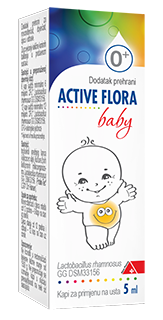Active Flora baby
Active Flora baby drops, food supplement, contain Lactobacillus rhamnosus GG DSM33156 (Probio-Tec® LGG®, Chr. Hansen) and it is intended for newborns, infants, children and adults.
It can also be used in premature babies and newborns with low birth weight.
6 drops contain 6 x 109 CFU.
Efficiency and safety of use of L. rhamnosus GG is confirmed in numerous clinical studies and recommended by the The European Society for Paediatric Gastroenterology Hepatology and Nutrition (ESPGHAN)1 and World Gastroenterological Organization (WGO)2.
Lactobacillus rhamnosus GG:
- reduces the risk of symptoms of diarrhea in antibiotic therapy1
- significantly reduces the duration of diarrhea in acute infectious diarrhea in children3
- improves immune response4
- is used as prevention and therapy in Atopic eczema associated with cow’s milk allergy4
Active Flora baby
- contains the most studied LGG strain
- contains coconut oil, MCT coconut oil
- does not contain gluten
- does not contain allergenic substances such as: proteins of cow’s milk, lactose, sucrose.
- does not contain artificial pigments, dyes and preservatives.
The recommended daily doses should not be exceeded. A dietary supplement is not a substitute or replacement for a a balanced diet. Keep out of reach of small children. It is important to adhere to a balanced and varied diet and a healthy lifestyle.


